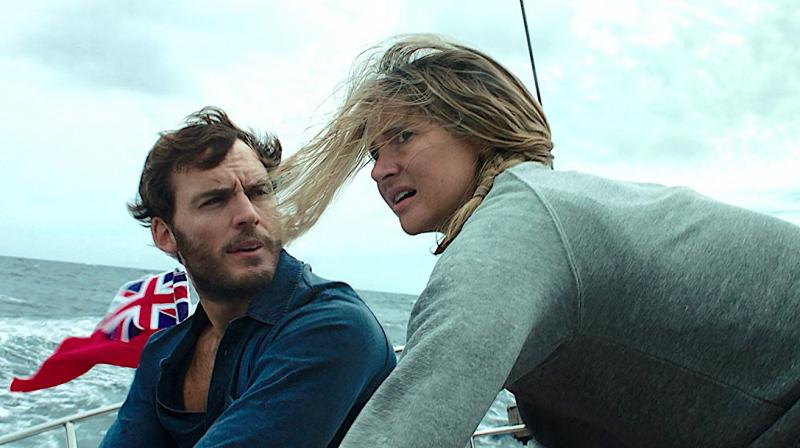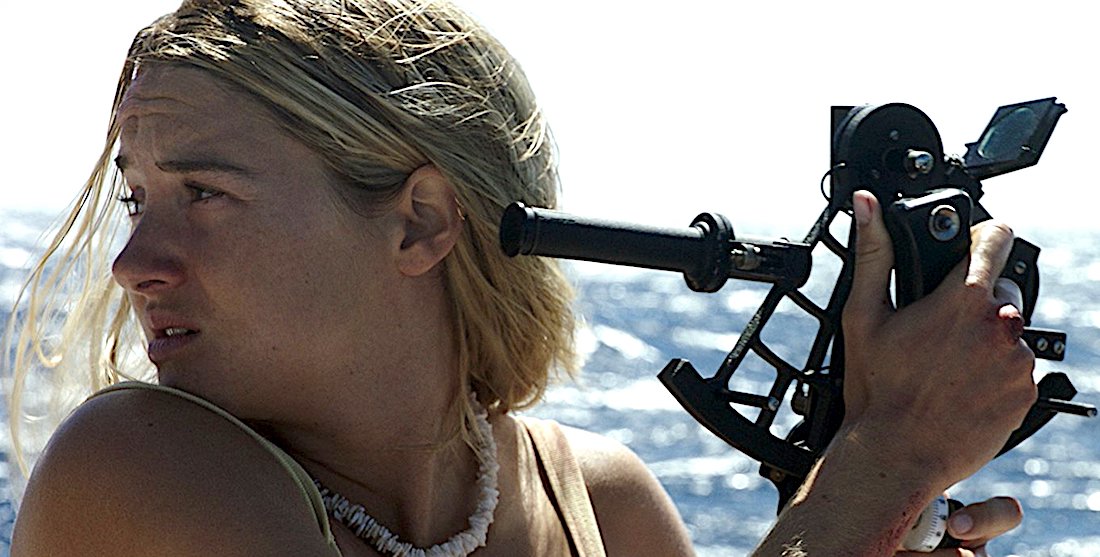Adrift review - lost at sea | reviews, news & interviews
Adrift review - lost at sea
Adrift review - lost at sea
Oceanic epic of love, storms and survival

There is something irresistibly haunting about tales of epic sea voyages and the perils they entail. Recently we’ve had two versions of the tragic saga of lone yachtsman Donald Crowhurst (not to mention the excellent documentary Deep Water from 2006), and you could lob into the mix the Robert Redford vehicle All Is Lost, Kon-Tiki, White Squall and… er… many more.
But never mind the competition, because Adrift can stand proud as one of the finest specimens of this watery genre. Based on the true story of Tami Oldham and Richard Sharp, which Oldham later set down in her book Red Sky in Mourning, it’s the tale of how in 1983 the couple set out to sail from Tahiti to San Diego, California (a journey of a paltry 4,000 miles). The journey was a kind of celebration of their blossoming love affair, and evidently had a “two drifters off to see the world” quality about it. Disastrously however, the hoped-for rainbow’s end was short-circuited by Hurricane Raymond, a monstrous storm which wrecked their boat and swept Sharp overboard. Director Baltasar Kormákur has been a competitive sailor himself and also made the vertiginous disaster movie Everest, so he has a firm grip on the terrors and exhilarations of the man-against-the-elements theme. Structurally, he starts off with Tami regaining consciousness after being knocked unconscious in the storm and finding herself and the now mast-less boat in the condition described in the title, then steadily works back and forth in time to colour in the story of how the pair met and gradually began to suspect that they were made for each other.
Director Baltasar Kormákur has been a competitive sailor himself and also made the vertiginous disaster movie Everest, so he has a firm grip on the terrors and exhilarations of the man-against-the-elements theme. Structurally, he starts off with Tami regaining consciousness after being knocked unconscious in the storm and finding herself and the now mast-less boat in the condition described in the title, then steadily works back and forth in time to colour in the story of how the pair met and gradually began to suspect that they were made for each other.
He got his casting spot on with his choice of leads. Shailene Woodley (who also produced) plays Tami as a wary, damaged soul, escaping from a fractured family background in California by bumming her way around the world’s oceans via a string of sailing jobs. When lone English yachtsman Sharp (Sam Claflin) sails cheerfully into the dock in Tahiti in the Mayaluga, a boat that he built himself, his eyes meet Tami’s across a crowded anchorage, and rather gauche social interaction is not long in coming. Sharp is nursing his own private wounds, stemming from his mother’s suicide, and the couple find an easy sympathy with each other between the limitless horizons of the Pacific.
Kormákur (pictured below on set) fully appreciates the wordless eloquence of sky, wind and water, and his sequences of yachts racing across a luminous, sparkling ocean like seagoing greyhounds must have allowed him to rip up dozens of pages of dialogue. The way the couple bond against a background of spectacular sunsets and days of jumping off a cliff into the rock-pool below could give The Way We Were a run for its money.
 But the whip comes down when the pair accept an offer from Richard’s middle-aged English friends to sail their boat, the Hazana, to San Diego. The lure of exotic adventure plus a financial incentive make it too good to turn down. Nobody expected a mega-storm which resembled an H-bomb blast on the radar plot, and when the boat becomes little more than a scrap of flotsam in the teeth of terrifying, gargantuan waves and howling winds, the terror is palpable.
But the whip comes down when the pair accept an offer from Richard’s middle-aged English friends to sail their boat, the Hazana, to San Diego. The lure of exotic adventure plus a financial incentive make it too good to turn down. Nobody expected a mega-storm which resembled an H-bomb blast on the radar plot, and when the boat becomes little more than a scrap of flotsam in the teeth of terrifying, gargantuan waves and howling winds, the terror is palpable.
It seems like a miracle when the traumatised Tami spots Richard through her binoculars, clinging to the wreckage of the Hazana’s dinghy. Though he’s suffering severe leg and rib injuries they’re able to discuss possible survival strategies, with Tami gambling that with a bit of luck they might be able to reach Hawaii. It’s Tami who has to shoulder the burden of being nurse, navigator and caterer, eking out the boat’s meagre supply of stuff in tins in between charting their position with pencil and set-square, and Woodley steps up with a performance of dogged, down-to-the-wire stoicism. The director makes the 41-day survival marathon gruelling, but not quite unbearable to watch.
It’s a stirring, emotional story that leaves a dream-like afterglow. There’s a major twist in the tail which may make you think Kormákur is pushing his luck, but it worked for me. And if you’ll excuse me, I must go down to the seas again, to the lonely sea and the sky…
The future of Arts Journalism
You can stop theartsdesk.com closing!
We urgently need financing to survive. Our fundraising drive has thus far raised £49,000 but we need to reach £100,000 or we will be forced to close. Please contribute here: https://gofund.me/c3f6033d
And if you can forward this information to anyone who might assist, we’d be grateful.

Subscribe to theartsdesk.com
Thank you for continuing to read our work on theartsdesk.com. For unlimited access to every article in its entirety, including our archive of more than 15,000 pieces, we're asking for £5 per month or £40 per year. We feel it's a very good deal, and hope you do too.
To take a subscription now simply click here.
And if you're looking for that extra gift for a friend or family member, why not treat them to a theartsdesk.com gift subscription?
more Film
 London Film Festival 2025 - crime, punishment, pop stars and shrinks
Daniel Craig investigates, Jodie Foster speaks French and Colin Farrell has a gambling habit
London Film Festival 2025 - crime, punishment, pop stars and shrinks
Daniel Craig investigates, Jodie Foster speaks French and Colin Farrell has a gambling habit
 I Swear review - taking stock of Tourette's
A sharp and moving tale of cuss-words and tics
I Swear review - taking stock of Tourette's
A sharp and moving tale of cuss-words and tics
 A House of Dynamite review - the final countdown
Kathryn Bigelow's cautionary tale sets the nuclear clock ticking again
A House of Dynamite review - the final countdown
Kathryn Bigelow's cautionary tale sets the nuclear clock ticking again
 theartsdesk Q&A: Idris Elba on playing a US President faced with a missile crisis in 'A House of Dynamite'
The star talks about Presidential decision-making when millions of lives are imperilled
theartsdesk Q&A: Idris Elba on playing a US President faced with a missile crisis in 'A House of Dynamite'
The star talks about Presidential decision-making when millions of lives are imperilled
 Urchin review - superb homeless drama
Frank Dillane gives a star-making turn in Harris Dickinson’s impressive directorial debut
Urchin review - superb homeless drama
Frank Dillane gives a star-making turn in Harris Dickinson’s impressive directorial debut
 Mr Blake at Your Service review - John Malkovich in unlikely role as an English butler
Weird comedy directed by novelist Gilles Legardinier
Mr Blake at Your Service review - John Malkovich in unlikely role as an English butler
Weird comedy directed by novelist Gilles Legardinier
 Don't Let's Go to the Dogs Tonight review - vivid adaptation of a memoir about a Rhodesian childhood
Embeth Davidtz delivers an impressive directing debut and an exceptional child star
Don't Let's Go to the Dogs Tonight review - vivid adaptation of a memoir about a Rhodesian childhood
Embeth Davidtz delivers an impressive directing debut and an exceptional child star
 One Battle After Another review - Paul Thomas Anderson satirises America's culture wars
Leonardo DiCaprio, Teyana Taylor, and Sean Penn star in a rollercoasting political thriller
One Battle After Another review - Paul Thomas Anderson satirises America's culture wars
Leonardo DiCaprio, Teyana Taylor, and Sean Penn star in a rollercoasting political thriller
 Steve review - educator in crisis
Cillian Murphy excels as a troubled headmaster working with delinquent boys
Steve review - educator in crisis
Cillian Murphy excels as a troubled headmaster working with delinquent boys
 Can I get a Witness? review - time to die before you get old
Ann Marie Fleming directs Sandra Oh in dystopian fantasy that fails to ignite
Can I get a Witness? review - time to die before you get old
Ann Marie Fleming directs Sandra Oh in dystopian fantasy that fails to ignite
 Happyend review - the kids are never alright
In this futuristic blackboard jungle everything is a bit too manicured
Happyend review - the kids are never alright
In this futuristic blackboard jungle everything is a bit too manicured

Add comment